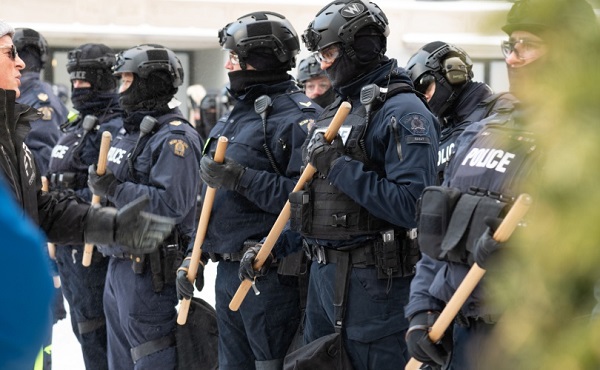COVID-19
Evidence on the origin of Covid leads to lab in Wuhan – Former NY Times Science Editor

In the millions of articles, opinion pieces, and news stories written about Covid there is one topic that is more important than all the others. It’s more important than masks, vaccines, or lockdown measures. The origin of the virus is critical because no matter how many people die from covid, or how many businesses are wiped out, it’s critical that IF the next virus can be stopped, it mu st be.
A science writer named Nicholas Wade has written the most thorough study on the origins of Covid to be released to the public. Wade has worked with Nature, Science, and the New York Times, but this article was released on the public platform Medium. In this article Wade goes through three possible scenarios and then draws the most likely conclusion. This is a long read, but it might be the most important article yet written during this pandemic.
Here is the beginning of this extensive article from Medium. Click here to read the full article on Medium.
Origin of Covid — Following the Clues
Did people or nature open Pandora’s box at Wuhan?
Nicholas Wade
I’m a science writer and have worked on the staff of Nature, Science and, for many years, on the New York Times. [email protected]
The Covid-19 pandemic has disrupted lives the world over for more than a year. Its death toll will soon reach three million people. Yet the origin of pandemic remains uncertain: the political agendas of governments and scientists have generated thick clouds of obfuscation, which the mainstream press seems helpless to dispel.
In what follows I will sort through the available scientific facts, which hold many clues as to what happened, and provide readers with the evidence to make their own judgments. I will then try to assess the complex issue of blame, which starts with, but extends far beyond, the government of China.
By the end of this article, you may have learned a lot about the molecular biology of viruses. I will try to keep this process as painless as possible. But the science cannot be avoided because for now, and probably for a long time hence, it offers the only sure thread through the maze.
The virus that caused the pandemic is known officially as SARS-CoV-2, but can be called SARS2 for short. As many people know, there are two main theories about its origin. One is that it jumped naturally from wildlife to people. The other is that the virus was under study in a lab, from which it escaped. It matters a great deal which is the case if we hope to prevent a second such occurrence.
I’ll describe the two theories, explain why each is plausible, and then ask which provides the better explanation of the available facts. It’s important to note that so far there is no direct evidence for either theory. Each depends on a set of reasonable conjectures but so far lacks proof. So I have only clues, not conclusions, to offer. But those clues point in a specific direction. And having inferred that direction, I’m going to delineate some of the strands in this tangled skein of disaster.
A Tale of Two Theories
After the pandemic first broke out in December 2019, Chinese authorities reported that many cases had occurred in the wet market — a place selling wild animals for meat — in Wuhan. This reminded experts of the SARS1 epidemic of 2002 in which a bat virus had spread first to civets, an animal sold in wet markets, and from civets to people. A similar bat virus caused a second epidemic, known as MERS, in 2012. This time the intermediary host animal was camels.
The decoding of the virus’s genome showed it belonged to a viral family known as beta-coronaviruses, to which the SARS1 and MERS viruses also belong. The relationship supported the idea that, like them, it was a natural virus that had managed to jump from bats, via another animal host, to people. The wet market connection, the only other point of similarity with the SARS1 and MERS epidemics, was soon broken: Chinese researchers found earlier cases in Wuhan with no link to the wet market. But that seemed not to matter when so much further evidence in support of natural emergence was expected shortly.
Wuhan, however, is home of the Wuhan Institute of Virology, a leading world center for research on coronaviruses. So the possibility that the SARS2 virus had escaped from the lab could not be ruled out. Two reasonable scenarios of origin were on the table.
From early on, public and media perceptions were shaped in favor of the natural emergence scenario by strong statements from two scientific groups. These statements were not at first examined as critically as they should have been.
“We stand together to strongly condemn conspiracy theories suggesting that COVID-19 does not have a natural origin,” a group of virologists and others wrote in the Lancet on February 19, 2020, when it was really far too soon for anyone to be sure what had happened. Scientists “overwhelmingly conclude that this coronavirus originated in wildlife,” they said, with a stirring rallying call for readers to stand with Chinese colleagues on the frontline of fighting the disease.
Contrary to the letter writers’ assertion, the idea that the virus might have escaped from a lab invoked accident, not conspiracy. It surely needed to be explored, not rejected out of hand. A defining mark of good scientists is that they go to great pains to distinguish between what they know and what they don’t know. By this criterion, the signatories of the Lancet letter were behaving as poor scientists: they were assuring the public of facts they could not know for sure were true.
It later turned out that the Lancet letter had been organized and drafted by Peter Daszak, president of the EcoHealth Alliance of New York. Dr. Daszak’s organization funded coronavirus research at the Wuhan Institute of Virology. If the SARS2 virus had indeed escaped from research he funded, Dr. Daszak would be potentially culpable. This acute conflict of interest was not declared to the Lancet’s readers. To the contrary, the letter concluded, “We declare no competing interests.”

Virologists like Dr. Daszak had much at stake in the assigning of blame for the pandemic. For 20 years, mostly beneath the public’s attention, they had been playing a dangerous game. In their laboratories they routinely created viruses more dangerous than those that exist in nature. They argued they could do so safely, and that by getting ahead of nature they could predict and prevent natural “spillovers,” the cross-over of viruses from an animal host to people. If SARS2 had indeed escaped from such a laboratory experiment, a savage blowback could be expected, and the storm of public indignation would affect virologists everywhere, not just in China. “It would shatter the scientific edifice top to bottom,” an MIT Technology Review editor, Antonio Regalado, said in March 2020.
A second statement which had enormous influence in shaping public attitudes was a letter (in other words an opinion piece, not a scientific article) published on 17 March 2020 in the journal Nature Medicine. Its authors were a group of virologists led by Kristian G. Andersen of the Scripps Research Institute. “Our analyses clearly show that SARS-CoV-2 is not a laboratory construct or a purposefully manipulated virus,” the five virologists declared in the second paragraph of their letter.

Unfortunately this was another case of poor science, in the sense defined above. True, some older methods of cutting and pasting viral genomes retain tell-tale signs of manipulation. But newer methods, called “no-see-um” or “seamless” approaches, leave no defining marks. Nor do other methods for manipulating viruses such as serial passage, the repeated transfer of viruses from one culture of cells to another. If a virus has been manipulated, whether with a seamless method or by serial passage, there is no way of knowing that this is the case. Dr. Andersen and his colleagues were assuring their readers of something they could not know.
The discussion part their letter begins, “It is improbable that SARS-CoV-2 emerged through laboratory manipulation of a related SARS-CoV-like coronavirus”. But wait, didn’t the lead say the virus had clearly not been manipulated? The authors’ degree of certainty seemed to slip several notches when it came to laying out their reasoning.
The reason for the slippage is clear once the technical language has been penetrated. The two reasons the authors give for supposing manipulation to be improbable are decidedly inconclusive.
First, they say that the spike protein of SARS2 binds very well to its target, the human ACE2 receptor, but does so in a different way from that which physical calculations suggest would be the best fit. Therefore the virus must have arisen by natural selection, not manipulation.
If this argument seems hard to grasp, it’s because it’s so strained. The authors’ basic assumption, not spelt out, is that anyone trying to make a bat virus bind to human cells could do so in only one way. First they would calculate the strongest possible fit between the human ACE2 receptor and the spike protein with which the virus latches onto it. They would then design the spike protein accordingly (by selecting the right string of amino acid units that compose it). But since the SARS2 spike protein is not of this calculated best design, the Andersen paper says, therefore it can’t have been manipulated.
But this ignores the way that virologists do in fact get spike proteins to bind to chosen targets, which is not by calculation but by splicing in spike protein genes from other viruses or by serial passage. With serial passage, each time the virus’s progeny are transferred to new cell cultures or animals, the more successful are selected until one emerges that makes a really tight bind to human cells. Natural selection has done all the heavy lifting. The Andersen paper’s speculation about designing a viral spike protein through calculation has no bearing on whether or not the virus was manipulated by one of the other two methods.
The authors’ second argument against manipulation is even more contrived. Although most living things use DNA as their hereditary material, a number of viruses use RNA, DNA’s close chemical cousin. But RNA is difficult to manipulate, so researchers working on coronaviruses, which are RNA-based, will first convert the RNA genome to DNA. They manipulate the DNA version, whether by adding or altering genes, and then arrange for the manipulated DNA genome to be converted back into infectious RNA.
Only a certain number of these DNA backbones have been described in the scientific literature. Anyone manipulating the SARS2 virus “would probably” have used one of these known backbones, the Andersen group writes, and since SARS2 is not derived from any of them, therefore it was not manipulated. But the argument is conspicuously inconclusive. DNA backbones are quite easy to make, so it’s obviously possible that SARS2 was manipulated using an unpublished DNA backbone.
And that’s it. These are the two arguments made by the Andersen group in support of their declaration that the SARS2 virus was clearly not manipulated. And this conclusion, grounded in nothing but two inconclusive speculations, convinced the world’s press that SARS2 could not have escaped from a lab. A technical critique of the Andersen letter takes it down in harsher words.
Science is supposedly a self-correcting community of experts who constantly check each other’s work. So why didn’t other virologists point out that the Andersen group’s argument was full of absurdly large holes? Perhaps because in today’s universities speech can be very costly. Careers can be destroyed for stepping out of line. Any virologist who challenges the community’s declared view risks having his next grant application turned down by the panel of fellow virologists that advises the government grant distribution agency.
The Daszak and Andersen letters were really political, not scientific statements, yet were amazingly effective. Articles in the mainstream press repeatedly stated that a consensus of experts had ruled lab escape out of the question or extremely unlikely. Their authors relied for the most part on the Daszak and Andersen letters, failing to understand the yawning gaps in their arguments. Mainstream newspapers all have science journalists on their staff, as do the major networks, and these specialist reporters are supposed to be able to question scientists and check their assertions. But the Daszak and Andersen assertions went largely unchallenged.
Doubts about natural emergence
Natural emergence was the media’s preferred theory until around February 2021 and the visit by a World Health Organization commission to China. The commission’s composition and access were heavily controlled by the Chinese authorities. Its members, who included the ubiquitous Dr. Daszak, kept asserting before, during and after their visit that lab escape was extremely unlikely. But this was not quite the propaganda victory the Chinese authorities may have been hoping for. What became clear was that the Chinese had no evidence to offer the commission in support of the natural emergence theory.
This was surprising because both the SARS1 and MERS viruses had left copious traces in the environment. The intermediary host species of SARS1 was identified within four months of the epidemic’s outbreak, and the host of MERS within nine months. Yet some 15 months after the SARS2 pandemic began, and a presumably intensive search, Chinese researchers had failed to find either the original bat population, or the intermediate species to which SARS2 might have jumped, or any serological evidence that any Chinese population, including that of Wuhan, had ever been exposed to the virus prior to December 2019. Natural emergence remained a conjecture which, however plausible to begin with, had gained not a shred of supporting evidence in over a year.
And as long as that remains the case, it’s logical to pay serious attention to the alternative conjecture, that SARS2 escaped from a lab.
Why would anyone want to create a novel virus capable of causing a pandemic?
To read the rest of this article on Medium click here
Nicholas Wade
I’m a science writer and have worked on the staff of Nature, Science and, for many years, on the New York Times. [email protected]
By the way.. Medium is a fascinating place. If you haven’t checked it out yet here’s a link to medium.com.
From About Medium:
We’re an open platform where 170 million readers come to find insightful and dynamic thinking. Here, expert and undiscovered voices alike dive into the heart of any topic and bring new ideas to the surface. Our purpose is to spread these ideas and deepen understanding of the world.
COVID-19
Canadian gov’t to take control of vaccine injury program after reports of serious mismanagement

From LifeSiteNews
The Canadian federal gov’t will take over the Vaccine Injury Support Program from Oxaro by March 2026 following reports of misallocated funds, unresolved claims, and unprofessional conduct.
The federal government is taking over Canada’s vaccine injury program after reports have discovered mismanagement.
The Public Health Agency of Canada (PHAC) is expected to take control of the Vaccine Injury Support Program (VISP) beginning on March 31, 2026, after a Global News report exposed the program for misallocating taxpayer funds and disregarding many vaccine-injured Canadians.
“We will publicly share further details on how the program will be delivered under PHAC when they become available,” Guillaume Bertrand, director of communications for Health Minister Marjorie Michel, told Global News.
Bertrand revealed that the government contract with Oxaro, the company tasked with running the VISP, will end in March, after which the federal government will take control.
“This is also part of our commitment to significantly reducing reliance on external consultants, while improving the capacity of the public service to hire expertise in-house,” Bertrand said.
Canada’s VISP was launched in December 2020 after the Canadian government gave vaccine makers a shield from liability regarding COVID-19 jab-related injuries; however, mismanagement within the program has led to many injured Canadians still waiting to receive compensation, while government contractors grow richer.
In July, Conservatives penned a letter calling for an investigation into the failing program, saying, “Despite the $50 million contract, over 1,700 of the 3,100 claims remain unresolved. Families dealing with life-altering injuries have been left waiting years for answers and support they were promised.”
Furthermore, the claims do not represent the total number of Canadians injured by the allegedly “safe and effective” COVID shots, as inside memos have revealed that Public Health Agency of Canada (PHAC) officials neglected to report all adverse effects from COVID shots and even went as far as telling staff not to report all events.
The PHAC’s downplaying of vaccine injuries is of little surprise to Canadians, as a 2023 secret memo revealed that the federal government purposefully hid adverse event reports so as not to alarm Canadians.
Of the $50.6 million that Oxaro Inc., has received, $33.7 million has been spent on administrative costs, compared to only $16.9 million going to vaccine-injured Canadians.
The letter further documented former VISP employees’ concerns that the program lacked professionalism and outlining what Conservatives described as “a fraternity house rather than a professional organization responsible for administering health-related claims.”
“Reports of constant workplace drinking, ping pong, and Netflix are a slap in the face to taxpayers and the thousands of Canadians waiting for support for life altering injuries,” the letter continued.
The federal government has ordered an audit into VISP. In late July, PHAC revealed that it is expediting its audit in light of reports of mismanagement within Oxaro.
COVID-19
Freedom Convoy leader slams Canadian gov’t agency for praising its treatment of protesters

From LifeSiteNews
Tamara Lich begs to differ with the Department of Public Safety’s claim that it acted with high ‘moral’ standards during the Freedom Convoy protests.
Freedom Convoy leader Tamara Lich is calling out Canada’s Department of Public Safety for “lies” after it boasted via an internal audit that it acted with a high “moral” standard in dealing with the 2022 protest against COVID mandates.
Lich made the comments on X earlier this week regarding a recent Department of Public Safety internal audit that heaped praise on itself for having “ethics” as well as a “moral compass” in dealing with the 2022 protesters.
The reality is that the self-boasting report comes after it was made known the Department of Public Safety had a role in spreading false claims that the Freedom Convoy was violent and was somehow funded by Russia.
As reported by Blacklock’s Reporter, the audit did not mention the false claims it made against the Freedom Convoy, which were used to allow then-Prime Minister Justin Trudeau to impose the Emergencies Act (EA) to clear out the protesters.
Indeed, in 2023, as reported by LifeSiteNews, disclosed records showed that Canada’s Department of Public Safety fabricated a security bulletin that claimed the Freedom Convoy protesters had plundered federal office buildings in an apparent attempt to discredit the movement.
The fake bulletin was sent out on January 28, 2022, at 3:54 p.m. and read: “We have received confirmation that protesters have started to enter office buildings in the Ottawa downtown core and are allegedly causing damage.”
The department’s recent boasting about itself, however, claimed that “(v)alues and ethics serve as a moral compass, guiding and establishing benchmarks for behaviour, decisions, actions and culture within organizations, including the public sector.”
“Federal public servants have a duty to preserve public trust and uphold a professional, non-partisan public service,” the internal audit noted.
Lich: Trudeau officials spread ‘lies, misinformation, disinformation, and division nationwide’
Regarding the recent audit, Lich noted that the Public Order Emergency Commission (POEC) hearing, which was tasked with investigating Trudeau’s use of the EA to crush the Freedom Convoy in mid-February 2022, “showed no violence or threats to national security during the 2022 Freedom Convoy.”
“It revealed a cycle between media and law enforcement, each repeating unverified talking points from the other. Despite widespread support along highways, overpasses, and communities, the CBC and other taxpayer-funded media missed an opportunity to unite Canadians,” she wrote.
Lich believes that Trudeau’s governmental departments “instead” spread “lies, misinformation, disinformation, and division nationwide.”
“Consequently, some of us face regular death threats, hate mail, threats of violence, and public harassment,” she wrote.
“Thankfully, we receive much more love and support, but the damage is done, which is exactly what they were aiming for.”
The sentencing trial for Lich and fellow Freedom Convoy leader Chris Barber took place in July at a hearing. Earlier this year, they were found guilty of mischief in their roles in the 2022 convoy.
As reported by LifeSiteNews, Lich revealed that the Canadian federal government is looking to put her in jail for no less than seven years and Barber for eight years.
A sentencing hearing has been scheduled in their case for October 7 in Ottawa.
The Freedom Convoy protest took place in early 2022 in Ottawa and featured thousands of Canadians calling for an end to COVID mandates.
In response, Trudeau’s federal government enacted the Emergencies Act on February 14, 2022, to shut down the popular movement.
Trudeau had disparaged unvaccinated Canadians, saying those opposing his measures were of a “small, fringe minority” who hold “unacceptable views” and do not “represent the views of Canadians who have been there for each other.”
Trudeau revoked the EA on February 23 after the protesters had been cleared out.
-

 Duane Rolheiser2 days ago
Duane Rolheiser2 days agoUnite the Kingdom Rally: demonstrators take to the streets in historical numbers to demand end to mass migration in the UK
-

 International2 days ago
International2 days agoTrump to Confront Starmer Over UK Free Speech Laws During State Visit
-

 Automotive2 days ago
Automotive2 days agoMichigan could be a winner as companies pull back from EVs
-

 Crime2 days ago
Crime2 days agoOlder man arrested at Kirk shooting admits to protecting real gunman
-

 Alberta13 hours ago
Alberta13 hours agoSylvan Lake high school football coach fired for criticizing gender ideology sends legal letter to school board
-

 Crime2 days ago
Crime2 days agoCanadian teacher showed Charlie Kirk assassination video to young students, said he deserved to die
-

 Business2 days ago
Business2 days agoDeportations causing delays in US construction industry
-

 Alberta1 day ago
Alberta1 day agoParents group blasts Alberta government for weakening sexually explicit school book ban



